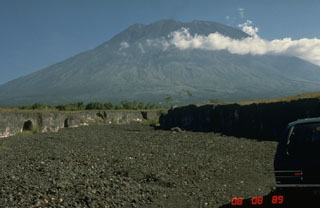Report on Agung (Indonesia) — 29 November-5 December 2017
Smithsonian Institution / US Geological Survey
Weekly Volcanic Activity Report, 29 November-5 December 2017
Managing Editor: Sally Sennert.
Please cite this report as:
Global Volcanism Program, 2017. Report on Agung (Indonesia) (Sennert, S, ed.). Weekly Volcanic Activity Report, 29 November-5 December 2017. Smithsonian Institution and US Geological Survey.
Agung
Indonesia
8.343°S, 115.508°E; summit elev. 2997 m
All times are local (unless otherwise noted)
PVMBG reported that the eruption at Agung, which began on 21 November, continued during 30 November-5 December. On 29 November gray ash plumes levels were rising to 2 km above the crater rim, resulting in ashfall to the SE. During 30 November-5 December emissions continued to rise 2 km; most were white in color, but dense gray ash emissions were noted during 1-2 December. Satellite data indicated that lava effusion continued at least through 1 December, and the erupted volume of lava was estimated to be 20 million cubic meters, equivalent to about a third of the total crater volume. The base of the plume was often reddish during 29 November-5 December reflecting incandescence from lava in the crater. BNPB noted on 5 December that 63,885 evacuees were distributed in 225 evacuation shelters.
Lahars were first noted on 21 November and continued to be observed through 5 December. The lahars flowed down drainages on the S flank (along the Tukad Yehsa, Tukad Sabuh, and Tukad Beliaung drainages) and also down the Tukad Bara drainage on the N flank, impacting houses, roads, and agricultural areas. The Alert Level remained at 4 (on a scale of 1-4), and the exclusion zones continued at a general 8-km radius and 10 km in the NNE, SE, S, and SW directions.
Geological Summary. Symmetrical Agung stratovolcano, Bali's highest and most sacred mountain, towers over the eastern end of the island. The volcano, whose name means "Paramount," rises above the SE rim of the Batur caldera, and the northern and southern flanks extend to the coast. The summit area extends 1.5 km E-W, with the high point on the W and a steep-walled 800-m-wide crater on the E. The Pawon cone is located low on the SE flank. Only a few eruptions dating back to the early 19th century have been recorded in historical time. The 1963-64 eruption, one of the largest in the 20th century, produced voluminous ashfall along with devastating pyroclastic flows and lahars that caused extensive damage and many fatalities.
Sources: Pusat Vulkanologi dan Mitigasi Bencana Geologi (PVMBG, also known as CVGHM), Badan Nacional Penanggulangan Bencana (BNPB)

